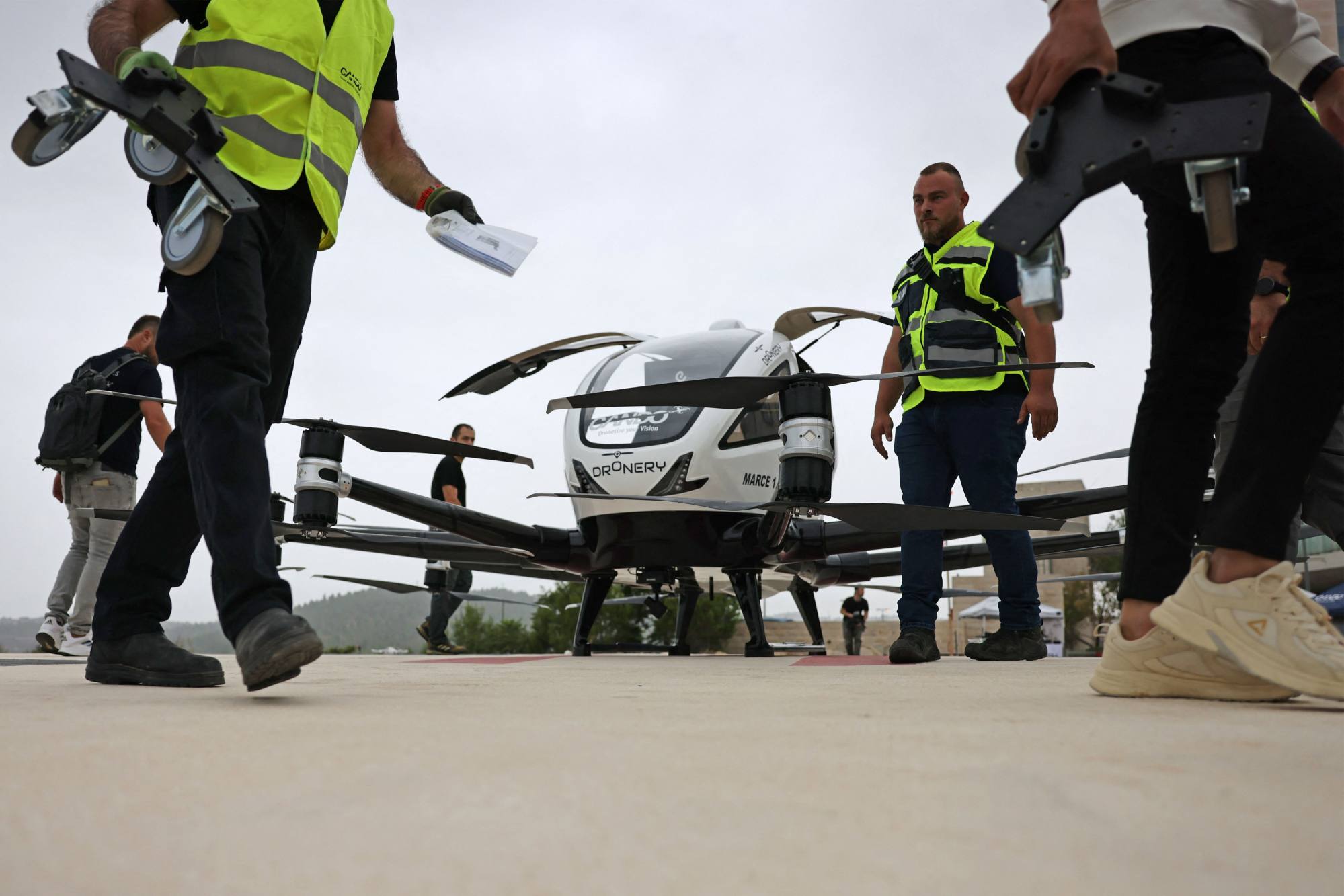-
EHang: EHang is one of the most well-known Chinese companies in the eVTOL industry. They have developed passenger-carrying autonomous aerial vehicles (AAVs) that can transport people short distances within cities. EHang's autonomous eVTOLs have conducted successful test flights and gained attention for their innovative approach to urban air transportation.
-
Volocopter: While Volocopter is a German company, they have partnered with Chinese investors and have a presence in China. They have developed a series of eVTOL aircraft designed for urban mobility, including the VoloCity and VoloConnect models.
-
SkyDrive: SkyDrive, a Japanese company with investments from Chinese investors, has been working on developing compact electric vertical takeoff and landing vehicles. While the company is not exclusively Chinese, it has had a presence in China and has worked on UAM projects in the region.
-
Xpeng (formerly XPeng Motors): While primarily known for its electric cars, Xpeng also announced its intent to explore the flying car market and UAM. They have indicated an interest in developing flying vehicles and have a research division dedicated to this endeavor.
-
Tencent and Geely: Chinese tech giant Tencent and automaker Geely formed a joint venture to explore the development of flying cars and related technologies. This partnership aimed to leverage Geely's automotive expertise and Tencent's technology prowess to advance UAM in China.
Traffic? I’m over it: Israel tests Chinese drone taxi in Jerusalem’s skies
An air taxi flew over Jerusalem on Wednesday as part of an Israeli experiment to develop a network of drones to offer transport services and ease traffic congestion.
The aircraft, manufactured by a Chinese company [eHang] , took off from the premises of Hadassah hospital in the city for a few minutes with its two passenger seats empty.
The electric-powered autonomous aircraft with white cockpit and propellers is capable of flying for more than 35km (over 20 miles), according to organisers of the showcase.
“What you see here is an air taxi that in the future will be able to carry people from place to place,” said Daniella Partem, senior director at Israel Innovation Authority.

Since 2019, Israel has been engaged in a high-profile programme known as Israel National Drone Initiative which aims to build air taxis to carry passengers and cargo in a bid to ease persistent traffic woes.
Israel has conducted more than 20,000 test flights of drones of different sizes, but Wednesday’s experiment was the first in front of the media.
The drone programme, which envisages an investment of 60 million Israeli shekels (US$16 million), is backed by several public and private companies.
Several operators would be able to fly from the same place at the same time, Partem told reporters. “So, if you want to fly a medical usage drone and food deliveries at the same time, you will be able to do that.”
Pilotless air taxi from China’s Ehang takes flight in the US for the first time
Chinese drone maker Ehang demonstrated its autonomous air taxi in the US for the first time. The all-electric two-seater took flight for five minutes above a test track south of Raleigh, North Carolina, on Tuesday afternoon, with approximately 100 people, including the state’s governor, Roy Cooper, looking on.
It represents the first time that Ehang has received permission to fly from the US Federal Aviation Administration, and it helped set the stage for it to receive approval for passenger demonstrations in the near future.
it’s the first time Ehang received permission to fly from the FAA
The Ehang 216, powered by 16 electric rotors, flew along a pre-planned route at over 80 mph. The aircraft weighs about 600 pounds and can carry another 500 to 600 pounds of cargo or passengers, the company says. But it’s still in its early stages of development and is primarily being used today for sightseeing trips.
North Carolina’s Department of Transportation arranged for the demonstration as part of its annual summit but also to serve as an example for the types of companies the state hopes to attract.
:format(webp)/cdn.vox-cdn.com/uploads/chorus_asset/file/19587156/EHang_216_in_flight.jpg)
Ehang
The future was delayed for about a half hour, because of problems with the radio signal, and people who had intently watched the horizon began to mill about. When the EH 216 suddenly rose up into the air, so did everyone’s cell phones.
[...]
After a five-minute flight over the test track, the EH 216 landed, and the crowd was allowed to walk down for a closer look. People posed with the craft for pictures, careful not to touch it.
Then with EHang’s blessing, some state officials opened the doors and sat in it. Eventually, [Gov. Roy] Cooper and [Ehang co-founder Derrick] Xiong walked down together and got in. As he did, Cooper, said the words that were no doubt on other people’s minds: “Meet George Jetson.”
:format(webp)/cdn.vox-cdn.com/uploads/chorus_asset/file/19587157/North_Carolina_Governor_Mr._Roy_Cooper_on_EHang_216.jpg)
Ehang
Ehang says it has conducted over 2,000 trial flights in China, Austria, the Netherlands, Qatar, the UAE, and now in the US. The company recently filed paperwork with the US Securities and Exchange Commission to go public on Nasdaq with a $100 million offering of depository shares. But it ultimately priced its shares at $12.50, which is at the low end of the range.
Ehang recently received approval from Chinese regulators to launch a commercial air mobility service in Guangzhou. As part of the pilot program, Ehang is working with the Guangzhou government to set up an air traffic control center. On the passenger front, Ehang has said it plans to use the pilot program to test more flight routes and “vertiports” from which its electric aircraft would take off and land. The company also plans to cargo deliveries of low-weight medical supplies, including blood and organs for emergency use.
Ehang is one of dozens of companies convinced that “flying cars” will become a viable mode of urban transportation in the future. These include drone makers, aerospace firms, ride-hailing companies, and even a few automakers. There are broad technical and regulatory challenges that could prevent this future from being realized, but the sheer number of prototypes that have taken flight around the globe suggests some version of an aerial taxi service may eventually come to pass.
Taxiing to take-off: are flying taxis the future of public transport?
1 May 2022

Taxiing to take-off: are flying taxis the future of public transport?
1 May 2022

According to her, “that will also help to create an economically viable market”.
SCMP Today: Intl Edition Newsletter
Start your day with our briefing on business, politics and important news stories from Hong Kong, Asia, and beyond.
By submitting, you consent to receiving marketing emails from SCMP. If you don't want these, tick here
Partem noted the rate of accidents recorded since the start of the tests was less than one per 2,000 flights.
“The first challenge for me is safety,” said Libby Bahat from Israel Civil Aviation Authority.
“Safety of the people on the ground, and in the future … the people on the aircraft,” he said, adding that safety parameters had to take into account roads, buildings and railways.
Once fully developed, the network would be useful in particular for transporting medicines, organisers said, and some test flights had carried out blood samples.
Bahat said the cost of such flights was difficult to estimate. It would remain relatively expensive for drones to deliver a “US$5 plate of sushi”.
Other countries have also performed test flights of air taxis, with France carrying out similar experiments ahead of the 2024 Summer Olympics in Paris.
Beat traffic by air: Israel flies drone taxi over Jerusalem
Beat traffic by air: Israel flies drone taxi over Jerusalem
Beat traffic by air: Israel flies drone taxi over Jerusalem
By Chloe Rouveyrolles-Bazire
Jerusalem (AFP) Sept 13, 2023
An air taxi flew over Jerusalem on Wednesday as part of an Israeli experiment to develop a network of drones to offer transport services and ease traffic congestion.
The aircraft, manufactured by a Chinese company, took off from the premises of Hadassah hospital in the city for a few minutes with its two passenger seats empty.
The electric-powered autonomous aircraft with white cockpit and propellers is capable of flying for more than 35 kilometres (over 20 miles), according to organisers of the showcase.
"What you see here is an air taxi that in the future will be able to carry people from place to place," said Daniella Partem, senior director at Israel Innovation Authority.
Since 2019, Israel has been engaged in a high-profile programme known as Israel National Drone Initiative which aims to build air taxis to carry passengers and cargo in a bid to ease persistent traffic woes.
Israel has conducted more than 20,000 test flights of drones of different sizes, but Wednesday's experiment was the first in front of the media.
The drone programme, which envisages an investment of 60 million Israeli shekels ($16 million), is backed by several public and private companies.
Several operators would be able to fly from the same place at the same time, Partem told reporters.
"So, if you want to fly a medical usage drone and food deliveries at the same time, you will be able to do that."
According to her, "that will also help to create an economically viable market."
Partem noted the rate of accidents recorded since the start of the tests was less than one per 2,000 flights.
"The first challenge for me is safety," said Libby Bahat from Israel Civil Aviation Authority.
"Safety of the people on the ground, and in the future... the people on the aircraft," he said, adding that safety parameters had to take into account roads, buildings and railways.
Once fully developed, the network would be useful in particular for transporting medicines, organisers said, and some test flights had carried out blood samples.
Bahat said the cost of such flights was difficult to estimate. It would remain relatively expensive for drones to deliver a "$5 plate of sushi".
Other countries have also performed test flights of air taxis, with France carrying out similar experiments ahead of the 2024 Summer Olympics in Paris.
Related Links
UAV News - Suppliers and Technology


No comments:
Post a Comment